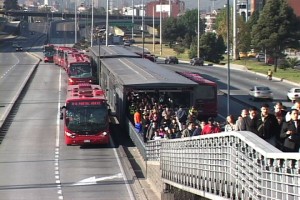
Bogota is a big city — roughly 7 million people. Prior to Transmilenio, public transportation was provided almost exclusively by private buses, known as colectivos, that can be flagged down at any point along their route. Transmilenio was designed to replace many of these private buses with a high quality, state of the art transport system that covers most of the city. As shown below, there also are over 150 miles of bicycle paths that run near the Transmilenio system, and there are substantial connections between the bicycle paths and the stations.
According to Transmilenio’s General Manager, Angelica Castro, roughly 75 percent of passengers use the express services rather than the local services. As shown by the photo below (which was taken at roughly 11 a.m.), it is not uncommon to have multiple local, limited, and express buses serving or passing stations at the same time. Unlike many US rail systems, where the wait between trains can be 10 or 15 minutes or more off-peak, there is almost always a vehicle serving a Transmilenio station. This greatly reduces travel time and enhances passenger convenience.
The current capital costs for Transmilenio are about $20 million per km, not including vehicles, according to Ms. Castro. Unlike US systems, however, all operations are conducted by private sector operators under contract to Transmilenio. Currently, these operators are paid roughly $2.2 per km of bus service provided.
The quality of service appears to be very high. Currently, the contracts between Transmilenio and the private operators require that the fleet average km/vehicle cannot exceed 850,000 km per vehicle. Each vehicle operates roughly 85,000 km per year, and every day roughly 240,000 km of service are provided on the trunk lines. The contracts require a thorough cleaning for each bus at the end of each day.
The result is a remarkably clean and well-maintained fleet that is used extensively by professionals and others with access to cars to make the same trip (see photo below right, which was taken during the evening peak). All of the stations are fully accessible, with ramps leading up from the streets and level boarding between the stations and the vehicles.